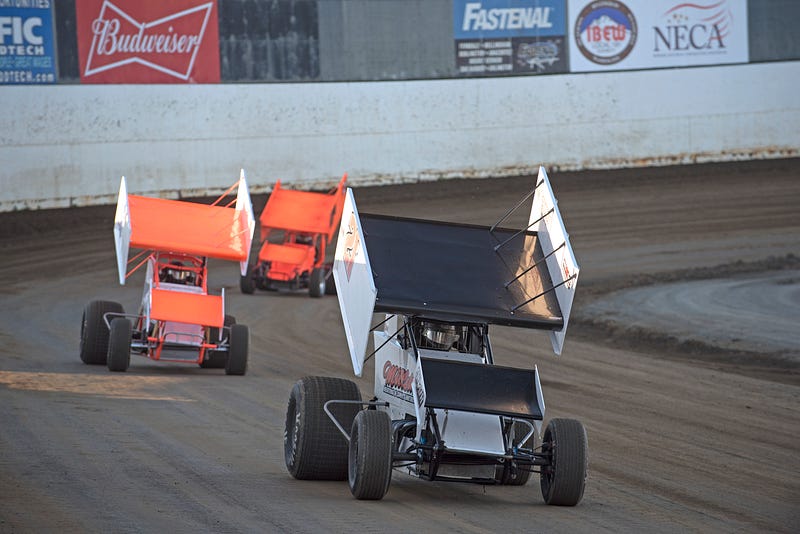Staying on Track
A labor of love for a historic speedway
Story by Andy Gibbs
Photos by Ed Clem

The crowd is poised with their popcorn bags clenched as Steppenwolf’s “Born to Be Wild” competes with engines revving like a swarm of bees and an commentator blaring over the public-address system. Floodlights illuminate the dirt track and the sun disappears as the night sky takes over. The flagger in the booth reaches over the railing, gives the signal and within seconds the sky fills with flying clods of dirt.
The owner of Skagit Valley Speedway and former sprint car driver, Steve Beitler, gives a hearty chuckle when he recalls the smells of the racetrack.
“We call it the smell of money,” Beitler says as small wrinkles brim on the edges of his smile.
In the driver’s seat of his racecar he smells methanol, hot rubber tires, exhaust fumes and the stink of burning oil from another car’s blown up engine or burnt rear end.
As early as Beitler can remember, Skagit Valley Speedway has been a part of his life.
It was built in 1954, the same year his father, Harold, competed in the track’s first race. Five years later, Beitler’s mother took him to his first race at 2 months old.
Beitler still makes memories with his father at the speedway. He recalls a moment from a few years back as they stood together atop the tower at the racetrack. Of all weekends together, this one was special. Beitler had arranged a fireworks show for the season finale race.

Starry explosions filled the sky. Harold looked over at Beitler with childlike excitement, shook his fist and exclaimed, “That’s the best fireworks show I’ve ever seen.”
Beitler has always wanted to race. In 1977, he built his first race car for a high school project. He started racing his senior year of high school and funded everything himself.
Beitler’s racing career is a success story. He took his career to the big leagues when he raced professionally for World of Outlaws, a professional sprint car racing series, for seven years. To this day, he misses racing. Despite retiring from the sport in 2001, he found a new opportunity to continue his passion that same year. Beitler purchased his childhood racetrack, Skagit Valley Speedway, to save it from going out of business.
From day one, Beitler has faced an uphill battle.
Thirty years ago, the main Saturday-night attraction of Skagit County and South Whatcom County was going to the races, Beitler says. It was easier to get people in the grandstands because there weren’t any casinos nearby and people didn’t have RVs, motorhomes or bay boats. He notices this trend in his clients and middle-aged customers, as well as himself.
“I’m 58 years old and even me, I don’t want to go the races every Saturday night,” Beitler says.
Forms of attractions and maintenance change to stay on the cutting edge. Trial and error play a large role in maintaining his business.
Two large losses stand out to Beitler throughout owning his business. In an attempt to improve the speedway, Beitler invested $40,000 to resurface the track. Unfortunately for Beitler, the surface would not tighten or compact as needed for racing. The dirt was too soft so he decided to remove that surface after the first race on the new track.
Beitler even considered the track as a possible concert venue. He spent $72,000 to make it happen, but due to lack of promotion and organization, the speedway only hosted one concert. Beitler took the whole production as a loss.
“Most people would have thrown the towel in, but I’ve never quit at anything in my life,” he says.
Just after Beitler’s failed attempts to bring business, the speedway went through a slump during the recession a few years ago. He lost sponsors, stopped advertising and borrowed from the bank to get through the off-season.

“There’s always those times when you wake up in the morning and you just have this gut wrenching feeling like ‘Oh what have I done,’” he says.
Despite past failures, Beitler looks toward the future. Beitler ruminates in what he calls his “think tank,” as he lays in bed and his ideas become plans.
Today, Skagit Valley Speedway is doing well and Beitler came out on the other side having learned a lesson or two.
In the past four to five years, Beitler attracted a wider crowd by adding more than just racing to the track, including truck and tractor pull. This competition involves seeing which vehicle can pull the heaviest load farthest.
Beitler accredits the growing variety in entertainment options as a challenge to keeping the racetrack successful.
“For a labor of love and surrounding myself with some really good people, we turned it around and built it back up into one of the premier racing facilities in the country,” Beitler says.
For the many of the staff at Skagit Valley Speedway, it’s a lifestyle. Beitler’s best friend since fourth grade, Mark Harrison, works track maintenance and Kandy Jager, the office manager, have been with Beitler since his first day. Others have worked at the track since it was built.
“I’ve told several [employees] at the end of the day if this place is going to fail, it’s going to fail by my design, not yours,” Beitler says.
The payoff for Beitler is seeing all of the families coming together and having fun at his racetrack and knowing he contributed toward creating a community.
As the sprint cars drift around the bend of the final lap, the commentator bursts over the PA and the crowd roars with excitement. A waving checkered flag signals the end of race and the crowd begins to pack up their belongings. The once thunderous racetrack has settled and the bright flood lights begin to shut off one by one. For some, it’s just another Saturday at the racetrack, but for those like Beitler, it’s life.
